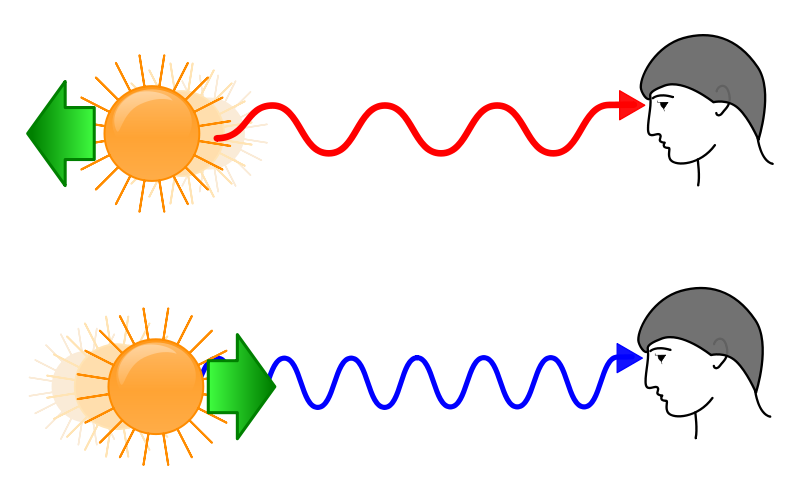Today I thought I would write about the Doppler Effect and Red Shift. What are they? Why do they occur? Why do we refer to Red Shift in the field of cosmology and astrology?
Red Shift is the name given to the perceived ‘shifting’ of waves through the spectrum from our perception. It gives us a measure of speed, or expansion, as is often the case. It can also called Blue Shift, and this is essentially the opposite of Red Shift. However, for the purposes of this post I shall refer to both of them as Red Shift unless otherwise stated.
Have you ever noticed the change in pitch when an object passes you at high-speed? Let’s take an ambulance or a Formula 1 car as an example. As it approaches we hear a higher than normal pitch, but as soon as the sound source starts to move away from us we hear a sudden drop in the pitch of the sound emanating from the source. Most people are aware of this phenomenon, but not so many fully understand it. It is useful for us to understand this, as it is almost the same as Red Shift, or at least it shares enough similarities with the Doppler Effect to be very useful towards our understanding of it. The effect I have just described to you has a special name, the Doppler Shift or the Doppler Effect, named after Christian Doppler who first proposed the effect in 1842.
It occurs because of the movement of either the sound source, the observer, or the medium through which the waves travel. Let’s suppose we have a static observer and a moving sound source (as per our F1 Car example). As the sound source approaches us, the sound waves are travelling the same direction as the sound source. The result of this is that the sound waves are slightly compressed, and a more compressed wavelength leads to a higher pitch. This continues up the point where the sound source is no longer travelling towards the observer. As soon as the sound source starts to move away from the observer we will notice a sudden change in the pitch, this is because the sound waves are no longer being compressed, they are instead being stretched. A stretched wave will have a longer wavelength, and this leads to a lower pitch as heard by the observer.
Now, we understand the Doppler Effect, so how is that useful towards our understanding of Red Shift? Well, it makes the understanding of Red Shift far easier I think. Doppler Effect occurs in waves where movement is involved, as I have described. So does Red Shift. In Doppler Effect we are dealing with sound waves whereas in Red or Blue Shift we are dealing with light waves. The fact that they are different wave types doesn’t make a difference, as they are both waves and so therefore behave in a fundamentally similar way.
The main difference between the two effects, Doppler Effect and Red Shift, is that instead of a shift in the perceived pitch, in Red Shift the observer will notice a shift in the observed colour. Light waves work in much the same way as sound waves. A compressed wave with a short wavelength will give you a colour that leans toward the blue end of the spectrum, and a stretched wave with an elongated wavelength will result in a shift towards the red end of the spectrum. This is just like the perceived pitch of the F1 car, but with the colour spectrum instead of audio spectrum. So, you are perhaps asking yourself “why this is useful”. We frequently stumble across examples of Doppler Effect in our day-to-day lives, but what about Red Shift, where is that useful? Well, it isn’t so useful on Earth, it is mainly referred to within the context of Space and is extremely useful within this area.
We know that we are in a universe that is expanding. That leads us to ask “How fast is the universe expanding”, and this is where we use the principles of Red Shift. If we look out to the skies through a telescope and spot an area of red, there is a chance that the object we observe wouldn’t actually be red if we were right up next to it, but because we are not and there is a whole lot of space between us and it there is room for lot of expansion. This room for expansion gives a lot of room for Red Shift, too. So how can we tell when an object is just red and when it has been red shifted? It is a good question. What we need is a constant, something that is always the same and that we understand, then we can measure the observed colour against the known colour and then this will give us our rate of expansion, or the degree of Red Shift that has occurred.
Lucky for us we have something like that which we can refer to. Supernovae. Wikipedia has this to say of Supernovae:
“Supernovae are extremely luminous and cause a burst of radiation that often briefly outshines an entire galaxy, before fading from view over several weeks or months. During this short interval, a supernova can radiate as much energy as the Sun could emit over its entire life span.” – Wikipedia
There is a type of Supernova, called 1a, that always behaves in the same way. As it explodes it always releases the same amount of light and peaks at exactly the same level of light intensity. This gives us a ‘signature’ explosion, a constant which will always be the same. So, anytime we want to measure the rate of expansion of a given area of the universe all we need to do is wait for a Supernova to occur and note what colour we observe. We will inevitably detect a shift towards the red end of the spectrum, and as we know exactly what colour the type 1a Supernova was at its peak, and we also know what colour we are observing as its peak, we can easily derive the speed at which the area of space is travelling, and thus the rate of expansion.
Equally, if we observed a supernova with a particularly blue tint to it, we would be able to derive that the given area of space is actually contracting, and we would again be able to calculate the exact rate of contraction through the methodologies listed above, though this time we would say that there was a Blue Shift, rather than a Red Shift.
So, that is essentially it. naturally with these topics there is a whole lot more going on ‘under the hood’, so to speak, but hopefully this explanation is enough to give you a grounding on the subject and understand some of the contexts in which this knowledge can be useful.




Nice, informative
Thanks, I’m glad you think so! 🙂